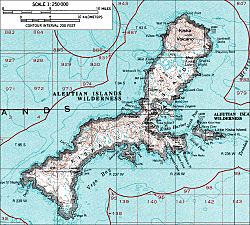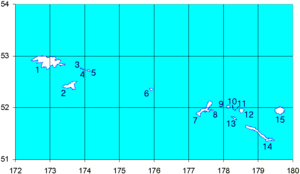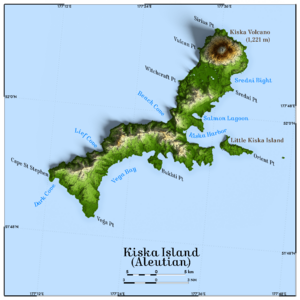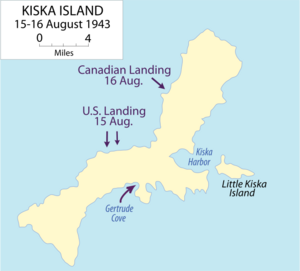Kiska facts for kids
|
Native name:
Qisxa
|
|
|---|---|

A topographical map of Kiska
|
|
| Geography | |
| Coordinates | 51°57′51″N 177°27′36″E / 51.96417°N 177.46000°E |
| Archipelago | Rat Islands group of the Aleutian Islands |
| Area | 107.22 sq mi (277.7 km2) |
| Length | 22 mi (35 km) |
| Width | 1.5 mi (2.4 km) - 6 mi (10 km) |
| Highest elevation | 4,004 ft (1,220.4 m) |
| Highest point | Kiska Volcano |
| Administration | |
|
United States
|
|
| State | Alaska |
| Census Area | Aleutians West Census Area |
| Demographics | |
| Population | 0 (2010) |
Kiska (also called Qisxa in the Aleut language) is one of the Rat Islands. These islands are a group within the larger Aleutian Islands chain in Alaska. Kiska is about 22 miles (35 km) long. Its width changes from 1.5 to 6 miles (2.4 to 9.7 km).
Kiska is part of the Aleutian Islands Wilderness. Because of this, you need special permission to visit it. No one lives on the island permanently.
Contents
Kiska Island: A Look Back
First European Visitors (1741)
In 1741, a Danish explorer named Vitus Bering, who was working for Russia, discovered Kiska Island. He was on his second big sea journey, called the Great Northern Expedition.
A scientist named Georg Wilhelm Steller was on Bering's ship. He wrote about seeing the island for the first time. He said they were surprised to find a "large tall island" on October 25, 1741.
Before Europeans arrived, native people had lived on Kiska Island for thousands of years.
After Discovery (1741–1939)
Russian traders started visiting Kiska and the other Rat Islands in the 1750s. They were mostly interested in hunting sea otters. After a while, they didn't visit the island as often. Sometimes, years would pass without any ships landing there.
Starting in 1775, Kiska and the Aleutian Islands became important places for fur trading. The Russian-American Company managed these trading posts.
In 1867, the United States bought Alaska from the Russian Empire. Kiska Island was included in this important purchase.
World War II (1939–1945)
During World War II, Japanese forces invaded Kiska on June 6, 1942. This was one of only two times the United States was invaded during the war. About 500 Japanese marines landed on the island. They captured ten U.S. Navy men and their dog, who were there for weather observations. One of the U.S. Navy men hid for 50 days before surrendering. The next day, the Japanese also captured Attu Island.
Kiska was a cold and hard-to-supply island. But losing U.S. land to an enemy for the first time since the War of 1812 had a big impact on Americans.
Over the winter of 1942–43, the Japanese made their defenses stronger on the islands. The U.S. Navy began to stop Japanese supply ships, which led to the Battle of the Komandorski Islands. American planes also bombed Kiska several times.
After U.S. forces recaptured Attu Island, they planned a much larger attack on Kiska. The Japanese knew a big Allied force was coming. So, on July 28, 1943, they secretly left the island under the cover of thick fog. The Allies didn't even know they were gone!
On August 15, 1943, a huge Allied invasion force landed on Kiska. There were over 34,000 troops from the U.S. and Canada, along with 95 ships and 168 aircraft. They were ready to fight the 5,200 Japanese soldiers they expected to find. But the island was completely empty.
Even though there were no Japanese soldiers, the Allies still had about 200 casualties. This was due to bad weather, Japanese booby traps left behind, or accidental "friendly fire" between U.S. and Canadian troops. Twenty-eight Americans and four Canadians were killed in these accidents. Many others suffered from trench foot because of the cold and wet conditions. A U.S. destroyer, USS Abner Read, hit a mine, causing 87 casualties.
That night, Japanese warships, thinking Americans were attacking, accidentally shelled and tried to torpedo Little Kiska, where their own soldiers were waiting to leave.
Kiska Since World War II
In 1985, the area where the Japanese were during the war was named a National Historic Landmark. It is now part of the Aleutian Islands World War II National Monument. Kiska is also part of the Alaska Maritime National Wildlife Refuge. It has the largest groups of least auklets and crested auklets, which are types of seabirds. Scientists have been studying how Norway rats affect these seabirds since 2001.
Many signs of World War II are still visible on Kiska. Bomb craters can still be seen on the hills. There are also old equipment dumps, tunnels, Japanese gun positions, and shipwrecks. Everything looks much like it did in 1943.
In 1983, a memorial plaque was placed on Kiska by the 87th Mountain Infantry Regiment. It honors the soldiers who died there in August 1943.
In 1989, divers from the United States Navy explored the wreck of a Japanese submarine, Ro-65. It sank in Kiska's harbor on November 3, 1942, and 19 lives were lost.
In 2007, the U.S. submarine USS Grunion, which disappeared during World War II with 70 crew members, was found off Kiska. It was about 1,000 meters (3,280 feet) underwater.
The island's landscape has not changed much since World War II. There are still unexploded bombs scattered around.
Kiska in Stories
Kiska Island was renamed "Skira" in the video game Operation Flashpoint: Dragon Rising. In the game, the island is moved closer to Russia and China. However, the game uses the real shape of Kiska Island for its setting.
Kiska Volcano
Kiska Volcano (called Qisxan Kamgii in Aleut) is an active stratovolcano. It is about 5.3 by 4.0 mi (8.5 by 6.4 km) wide at its base and 4,006 feet (1,221 m) tall. You can find it at the northern end of Kiska Island.
On January 24, 1962, the volcano had a big eruption. It shot out lava and built a new small cone, called a cinder cone, about 98 feet (30 m) high. This new cone formed near Sirius Point, about 1.9 miles (3.1 km) from the main volcano top. Another eruption happened on March 18, 1964, which also produced a lava flow.
Since then, Kiska Volcano has continued to release steam and ash clouds. It has also had smaller lava flows.
 In Spanish: Kiska para niños
In Spanish: Kiska para niños





